Contents
One of the most favorite plants of gardeners is the large-fruited cherry, which is a real champion among the trees of this species in terms of the size and weight of the fruit. Large-fruited cherries can be grown in almost any area, but first you need to study all its characteristics and features.
History of variety breeding
For the first time this variety was bred on the territory of Ukraine – its originators are breeders M.T. Oratovsky and N.I. Turovtsev. In the selection work, the sweet cherry variety Napoleon Belaya was used, and the varieties Elton, Valery Chkalov and Zhabulet acted as pollinators. In 1973, the new variety entered the test, and in 1983 it was entered into the State Register.

Description of the cherry variety Large-fruited
Black cherry Large-fruited is a medium-sized tree that can grow up to 5 meters in height. The main skeletal branches of the tree are few, but they are very durable and covered with rough bark.
The natural shape of the crown is usually spherical, unless artificially formed, and of medium density. Cherry leaves are unremarkable – oblong in shape, slightly pointed at the ends, juicy green. The easiest way to recognize a tree is by its white flowers, which bloom densely in April and envelop the entire cherry crown with a light veil.
A unique feature, thanks to which the variety got its expressive name, is an unusually massive cherry fruit. One berry can weigh from 10,4 to 12 g, occasionally there are even fruits weighing 18 g. The berries are round in shape, covered with a thin but dense skin, the color of which can vary from rich red to almost black. The pulp has the same color. According to the ripening time, this variety belongs to the category of mid-ripening cherries – the fruits appear around mid-late June.
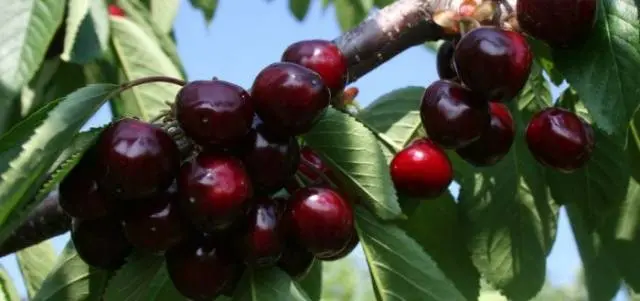
Ideal areas for growing large-fruited cherries are the southern regions, the Crimea and the Krasnodar Territory. However, the variety is also successfully cultivated in the middle lane – it all depends on the quality of care for Large-fruited, on proper watering and pre-winter processing of the plant.
Characteristics of a variety
In order to understand how large-fruited cherries are suitable for growing in a particular area, you need to carefully read the characteristics of the variety. How well does the tree tolerate lack of moisture, frost and pests?
Drought tolerance
This variety tolerates the lack of moisture quite well. On the hottest summer days, sweet cherries will need additional watering, but it is quite enough to do it once a week with 1 liters of water. The rest of the time, you can water the tree once a month in the amount of 50 – 20 liters of water under the trunk – this amount of moisture is enough for healthy growth of the sweet cherry.
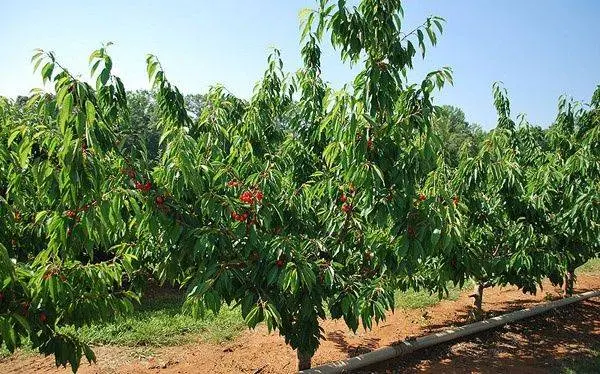
Frost resistance of sweet cherry Large-fruited
The variety was not created for negative temperatures, but tolerates them well. Winter colds in the middle lane, when the temperature drops to -25 degrees, do not harm an adult tree, especially if there is care. But the young seedlings of the variety are sensitive to low temperatures – that is why it is recommended to plant large-fruited cherries in spring, and not in autumn.
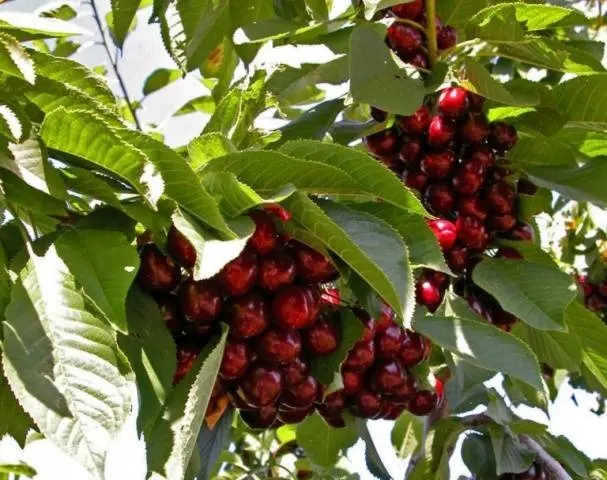
Sweet cherry pollinators
Large chokeberry belongs to self-fertile varieties. This means that next to it you will need to plant other varieties that will act as pollinators – only then will it be possible to harvest a bountiful harvest from the tree. For large-fruited pollinators can be:
- Cherry Francis – the flowering of the variety is early, it falls at the beginning of May, and ripening occurs by the end of June, at about the same time as the ripening of the large-fruited sweet cherry.
- Cherry Surprise – flowering of the variety begins in May, 5 – 10 numbers. But the fruits from this variety can be harvested only by mid-July.
- Diber Cherry Black – the variety blooms in medium terms, and its ripening is medium late. The fruits are usually harvested in late June – early July.
All of the listed varieties, planted next to the Large-fruited sweet cherry, will be able to guarantee a plentiful and high-quality harvest of the latter.
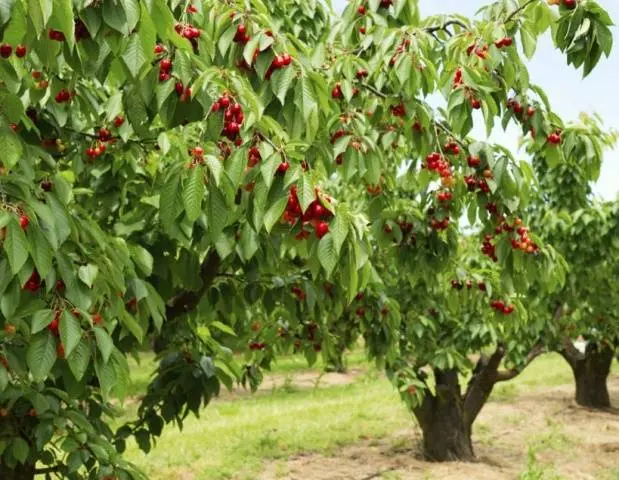
Yield and fruiting
The description of the large-fruited black cherry variety indicates that the fruits of the plant ripen in medium terms, and the crop appears in the second half of June. The tree does not begin to bear berries immediately, but only 3 years after the seedling is rooted in the garden.
As for the yield, the variety is simply amazing – one tree can produce up to 56 kg of fruit annually.
Scope of berries
Large, fleshy, sour-sweet fruits of large-fruited cherries have a high tasting score of 4,6 and can be used in cooking in a very diverse way. Berries are eaten fresh, useful juice is squeezed out of them, compotes and fruit drinks are cooked, jam is prepared for the winter. Cherries can be used as an ingredient in baking.
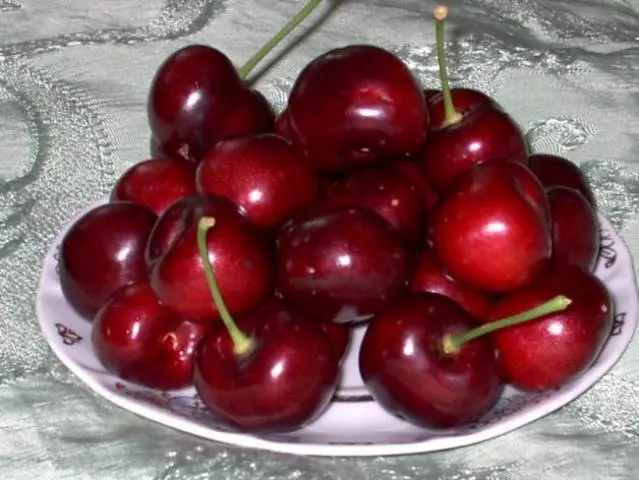
Disease and pest resistance
The variety is considered highly resistant to lesions from diseases and insects. However, with insufficient care and adverse weather, the large-fruited sweet cherry may also undergo some ailments. Of the diseases, cherries are most often affected by:
- destroyed – expressed in the appearance of yellow spots on green leaves;
- moniliasis – drying out of young branches and ovaries;
- kleasterosporiosis – bright red spots appear on the leaves, fruit growth stops;
- gum flow – the bark of the tree begins to exude resin, in which pathogenic bacteria settle.
The procedure for these lesions is approximately the same. Sick areas of the tree are removed, and healthy ones are treated with antiseptics.
Of the pests for the tree, aphids, weevil and cherry fly are especially dangerous. If insects are seen on the leaves or in the fruits of the Large-fruited, it must be urgently treated with appropriate solutions.

Advantages and disadvantages of the variety
The positive qualities of the Large-fruited sweet cherry are much greater than the disadvantages. The advantages include:
- the highest productivity;
- juicy and sweet taste of fruits;
- resistance to lack of moisture and low temperatures;
- resistance to pests and diseases that affect the tree very rarely;
- low maintenance requirement.
The minus of the variety can be called its sterility – pollinating varieties are required for abundant fruiting. Also, the disadvantage of the tree is intolerance to high soil moisture – in rainy seasons, problems can begin with cherries.
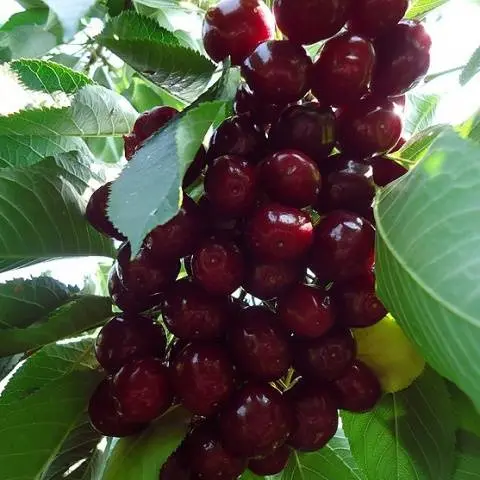
Planting and caring for sweet cherries
Cherry large-fruited red is a variety that is quite undemanding to external conditions. But you still need to know the basic rules of planting and care.
Recommended dates
Since young seedlings are very sensitive to cold weather, it is recommended to plant large-fruited sweet cherries not in autumn, but in spring – otherwise the shoots of the tree will simply freeze. Spring planting must be done on time – after the last frost, but before the start of the vegetative period in neighboring pollinating trees.
Choosing the right place
This variety loves the sun and warm air, so it is necessary to plant a tree in a well-lit area. The distance to the nearest trees should be about 3 meters.
The variety does not tolerate stagnant moisture, so marshy or clay soil is not suitable for it. The tree favorably perceives loam and sandy loamy soil with good ventilation opportunities.
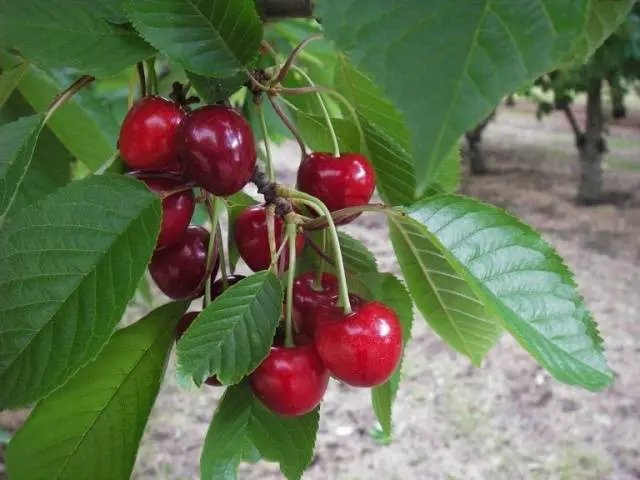
What crops can and cannot be planted nearby
It is not recommended to plant pears, apple trees and currants near the tree. But cherries of other varieties and cherries can be settled in the neighborhood.
Selection and preparation of planting material
The root system of the planting material must be developed and intact, and a graft mark must be visible on the trunk of the tree.
Landing algorithm
Planting a tree in the ground is carried out as follows:
- A pit is prepared – 2 times larger in volume than the size of the roots of the seedling.
- A layer of compost mixed with ordinary earth is laid out at the bottom of the pit.
- From above, fertilizer is covered with soil, a peg is dug in for a garter.
- A seedling is placed in the pit, spreading the roots over a layer of soil.
- From above, the earth is covered up to half of the pit, then a bucket of water is poured out and the earth is covered again – already to the end. After that, the soil around the tree is compacted, watered again, sprinkled with mulch.
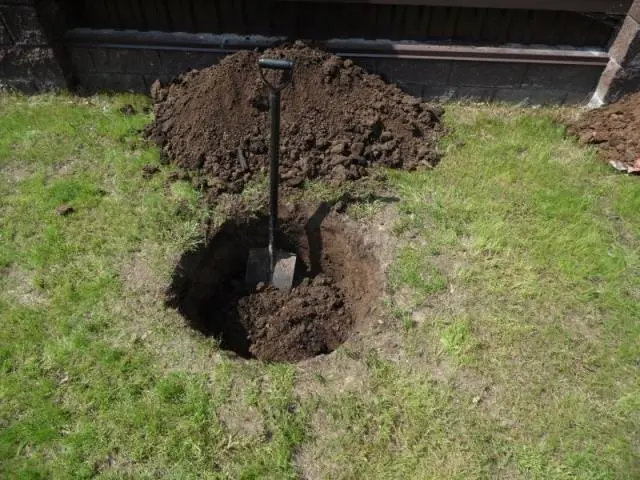
Aftercare for cherries
Caring for Large-fruited cherries will not require much effort from the gardener.
- You need to cut off dry and damaged shoots, as well as ordinary branches that begin to compete with the main ones. Remove branches that grow below the skeletal branches. Shoots are annually shortened by a quarter or half.
- In dry weather, young trees are watered with 20 – 40 liters of water monthly, an adult sweet cherry needs from 40 to 60 liters of water. During drought, watering is carried out weekly, and with heavy rainfall it is completely stopped.
- In the first 3 years, the tree does not require any fertilizer. For 3 years, it is recommended to scatter ammonium and saltpeter under the trunk – no more than 25 g per square meter of soil. Also, once every three years, it is recommended to scatter rotted manure near the trunk.
- The variety is resistant to diseases and harmful insects, the tree requires minimal protection. It will be useful to whitewash the trunk with slaked lime.
- Before the onset of winter, it is recommended to dig up the soil a little, make the last watering, and then cover the trunk with hay or spruce branches. Also, after leaf fall, the cherry should be sprayed with a solution of superphosphate.
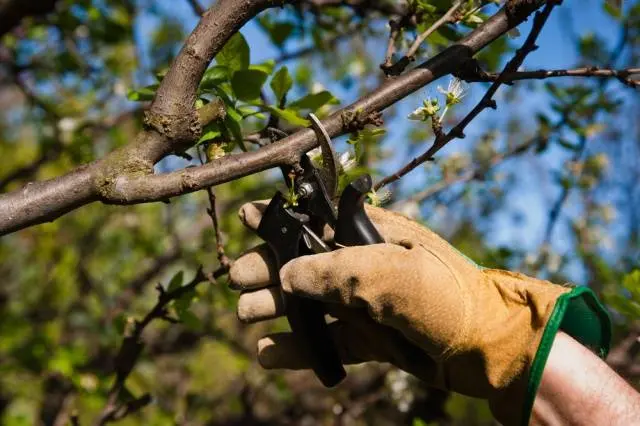
Diseases and pests, control and prevention measures
Large-fruited cherries are not recommended to be treated with chemicals without the need, since pests and diseases rarely affect them. As a preventive measure, it is enough to wrap the trunk with roofing felt to protect it from rodents, and in winter, form a snowdrift around the trunk.
Toxic drugs are resorted to only if the tree is really sick. To get rid of insects, Inta-Vir, Actellik and Decis solutions are used, and cuts and damage on the trunk and branches are treated with a solution of copper sulphate.
Conclusion
Large-fruited sweet cherry is a fairly unpretentious fruit tree. If you follow the elementary rules of pollination and care, the variety will delight you with very plentiful harvests.










